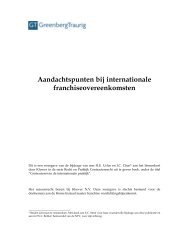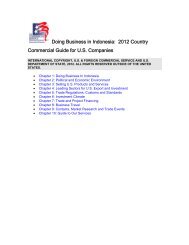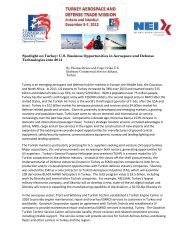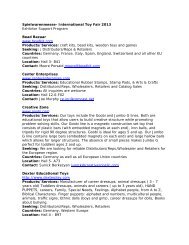CHINA: Franchising Industry - Export.gov
CHINA: Franchising Industry - Export.gov
CHINA: Franchising Industry - Export.gov
Create successful ePaper yourself
Turn your PDF publications into a flip-book with our unique Google optimized e-Paper software.
KEY INDUSTRY 3: FRANCHISING IN EDUCATION 15<br />
US Commercial Service – The JLJ Group<br />
China <strong>Franchising</strong> <strong>Industry</strong><br />
Page 10 of 23<br />
Note: this section will provide a brief snapshot of the education sector, with focus on a relatively more<br />
developed segment, language training. More detailed information for other segments and regulations<br />
may be found in the Education & Training report, which is also part of the USCS-JLJ series on China.<br />
Summary: <strong>Franchising</strong> in China’s Education Market Return to Top<br />
The education and training market has grown at average of about 20% annually in the last few years.<br />
<strong>Franchising</strong> is common in all of the three large segments: language training, IT training, and children’s<br />
education. However, foreign players are still a small part of the language training and children’s<br />
education segments due to restrictive regulations. Indian companies dominate the IT segment.<br />
Market Overview Return to Top<br />
Education & training market. Currently, there are about 93,200 domestic and international private<br />
education institutions in total. Language training (about 11% annual growth), IT training (~ 20% growth)<br />
and children’s education (~30% growth) are the three top segments. Demand for such services comes<br />
from both individual consumers and companies. Increased attention to education is also evident in the<br />
rising proportion of income spent on education. The value doubled between 1999 and 2004 and<br />
reached US$ 1,547 per capita in 2006.<br />
<strong>Franchising</strong>. Most consumers perceive large “branded” chains to be more reliable. Thus, franchising is<br />
popular as it is seen as a fast method of increasing the number of stores, and consequently increasing<br />
brand recognition. Not all large brands franchise, however – notably New Oriental and Wall Street<br />
English. In some cases, this is partly the result of restrictive regulations, especially for children’s<br />
education (more details can be found in the Education & Training Report). Finally, the IT segment is<br />
dominated by global Indian companies - Aptech and NIIT – which both franchise in China. This segment<br />
is thus more competitive and offers relatively less room for new smaller entrants.<br />
Drivers of growth. Demand for training is increasing due to shortage of qualified personnel that can<br />
meet international standards, especially managers. Corporate training courses are also used as a<br />
retention tool by large MNCs. Demand is also driven by individuals – young Chinese professionals are<br />
willing to spend an average of 10% of their salaries on ongoing training. In the children’s segment,<br />
growth is driven partly as a result of the one-child policy and fierce competition to get into the best<br />
schools.<br />
Competitive Landscape – Language Return to Top<br />
Tier 1 vs. Tier 2. There are more than 50,000 English language institutes throughout the country; only a<br />
few key players have national coverage, e.g. English First and New Oriental. However, the majority of<br />
outlets for these companies are still located in the economically developed East coast. Tier 2 cities offer<br />
good prospects as demand exceeds supply, especially since learning English has become a trend<br />
among the younger generation and is seen as a key skill to have for significantly enhancing one’s<br />
career prospects.<br />
Foreign vs. Domestic. Foreign companies are not preferred to domestic ones, as both can hire native<br />
speakers as teachers. The franchising model is used by English First and Web International (table 4)<br />
while others engage in JVs or partnerships with universities. 80% of domestic institutes use franchising,<br />
but many are small local companies.<br />
15 This section excludes the non-profit education sector

















